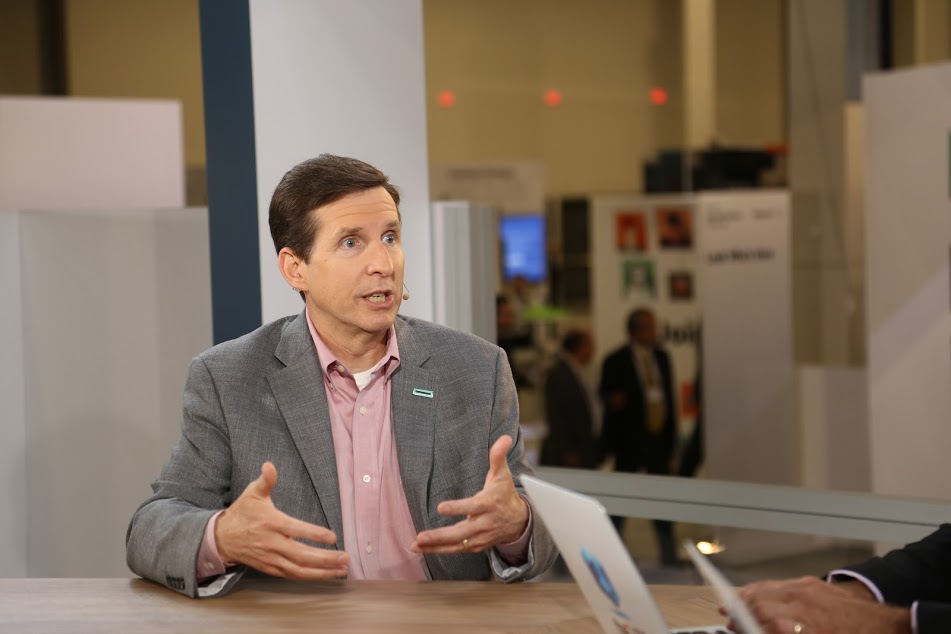 CLOUD
CLOUD
 CLOUD
CLOUD
 CLOUD
CLOUD
In demonstrating terabyte-level persistent memory at Discover 2017, Hewlett Packard Enterprise Co. is driving home the point that customers increasingly want their applications to run faster than in traditional storage systems. The big story here is speed, with 20 times faster database restore operations and 27 times faster application checkpoint processes, according to HPE.
“I think persistent memory is a good example of how we are way out ahead of where our competition is right now. Persistent memory unleashes an incredible amount of performance for the application running on the server,” said Tom Lattin (pictured), vice president and general manager of server operations at HPE, during HPE Discover US 2017 in Las Vegas, Nevada.
Lattin stopped by theCUBE, SiliconANGLE’s mobile livestreaming studio, to speak with co-hosts John Furrier (@furrier) and Dave Vellante (@dvellante) about the features of scalable persistent memory and how HPE is fine-tuning server platforms. (* Disclosure below.)
HPE has been focused on improving the agility of servers with persistent memory being a key feature. Last year, HPE introduced Persistent Memory as a category and launched the first product in the portfolio, an 8GB NVDIMM.
“We are extending that portfolio this year with the Gen10 servers and increasing the NVDIMM capacity to 16GB, but the really big news in the persistent memory offering is Scalable Persistent Memory,” Lattin said.
Scalable Persistent Memory is HPE’s new integrated storage solution that runs at memory speed with terabyte capacity. HPE considers it ideal for breaking through large bottlenecks in applications and accelerating the server performance using components that currently exist in data centers today, according to Lattin.
HPE claims a Persistent Memory implementation, whether with NVDIMMs or Scalable Persistent Memory, can replace a layer of flash storage and deliver the fastest persistent memory in the market at scale. Some of the performance benefits the company is touting are 20x faster restarts, based on a Microsoft SQL Hekaton in-memory database, and 27x faster checkpoint operations. HPE is seeing double the application performance when swapping out an SDD for their Persistent Memory, according to Lattin.
“If you look at some of the demonstrations we’ve done recently with the machine and with memory-driven computing, it’s about taking that shared presence of the data to an entirely new level,” said Lattin.
A key differentiator for HPE is the ability to fine-tune server platforms, integrating hardware, system software, BIOS and working with software application providers to optimize their applications to get more benefit from servers. “Part of what we bring to market is a set of server platforms that have an incredible breadth of capability,” Lattin stated.
In order to leverage this strategy, HPE is relying on its partners. Lattin cited Red Hat Inc., as an example, and described how Red Hat is taking HPE’s persistent memory technology and optimizing it for deployment to its own customers.
“Fundamentally, we are a partnering business; we work extensively with an ecosystem of software provider partners in the industry,” Lattin explained.
HPE’s Gen10 news represents yet another chapter in the evolution of memory-driven computing. As the demand for application processing on servers continues to rise, the company is seeking to leverage memory technology to meet customer needs.
“We’ve got terabyte scale persistent in the Gen10 platforms, which opens up a whole new world of opportunity for applications, developing performance in many cases 20, 25, 27 times the capabilities today,” Lattin concluded.
Watch the complete interview below and be sure to check out more of SiliconANGLE’s and theCUBE’s independent editorial coverage of HPE Discover US 2017. (* Disclosure: TheCUBE is a paid media partner for HPE Discover US 2017. Neither Hewlett Packard Enterprise Co. nor other sponsors have editorial control on theCUBE or SiliconANGLE.)
THANK YOU